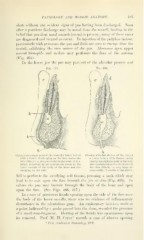Page 485 - My FlipBook
P. 485
PATHOLOGY AND MORBID ANATOMY. 483
abate without any evident signs of pus having been discharged. Soon
after a purulent discharge may be noted from the nostril, leading to the
belief that purulent nasal catarrh (ozena) is present many of these cases
;
are diagnosed and treated as ozena. In injection of the pulploss incisor,
particularly ^vith ])yrozone, the pus and fluid are seen to emerge from the
nostril, exhibiting the true source of the pus. Abscesses upon upper
second bicuspids and molars may perforate the iloor of the antrum
(Fig. 464V
In the lower jaw the pus may pass out of the alveolar process and
Fig. 465. Fig. 4G6.
Chronic alveolar abscess at the root of a lower incisor Chronic alveolar abscess of the root of
with a fistula discharging on the face under the a lower incisor with abscess cavity
chin (Black) : a, abscess cavity in the bone; b, b, b, passing through the body of the bone
fistula following in the periosteum down to the and discharging on the skinbeseath
lower margin of the body of the bone and dis- the chin (Black) : a, very large ab-
charging on the skin. scess cavity ; b, mouth of the fistula.
fail to perforate the overlying soft tissues, pursuing a path ^^ hich may
lead to its exit upon the face beneath the jaw or chin (Fig. 465). In
others the pus may burrow through the body of the bone and open
upon the face. (See Figs. 466, 467.)
In a case of persistent fistula opening upon the side of the face over
the body of the lower maxilla, there was no evidence of inflamniatory
disturbance in the edentulous gum. An exploratory incision, made at
a point indicated by a probe passed into the sinus, revealed the presence
of a small root-fragment. Healing of the fistula was spontaneous upon
its removal. Prof. M. H. Cryer^ records a case of abscess opening
- Proc. Academy of Stomatology, 1896.


